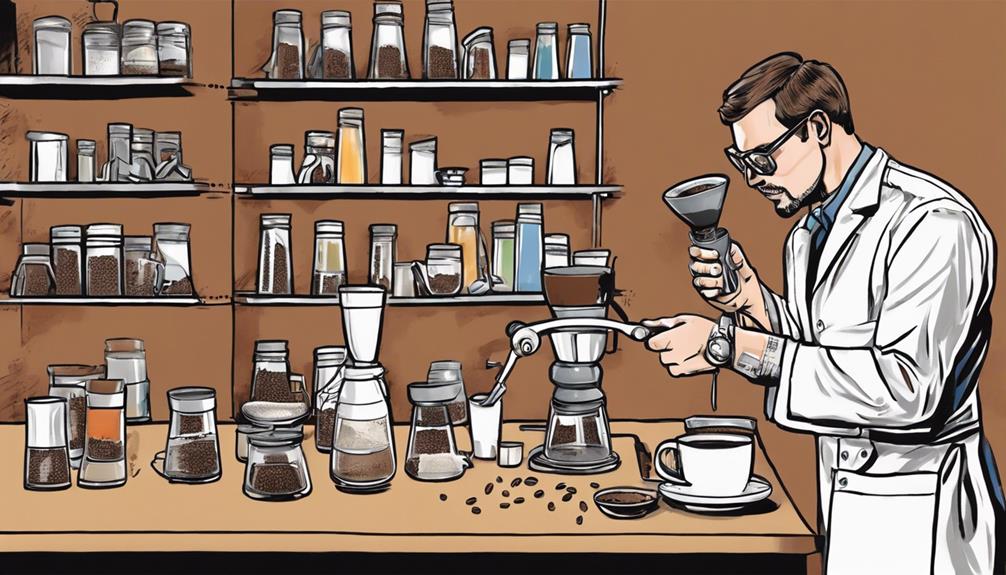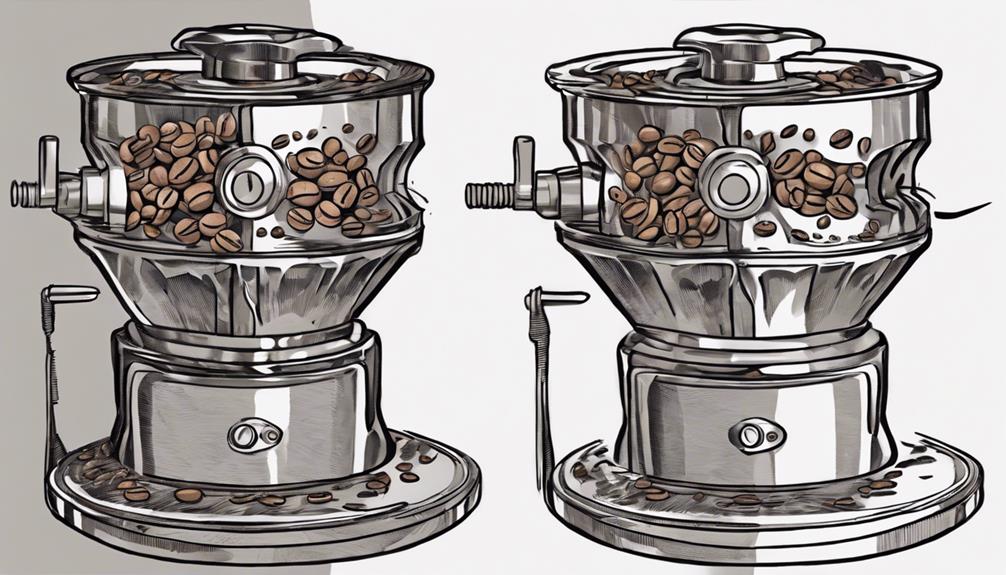To excel as a coffee connoisseur, dedicate yourself to intensive training to enhance your palate. Learn to recognize basic flavors and push yourself with blind taste tests. Pay close attention to the subtle differences in coffee blends and cultivate a keen sense of smell for complex aromas. Combine taste and smell to accurately identify flavors. Delve into aspects like texture, sweetness, acidity, and the aftertaste in coffee cupping. Distinguish between various flavor profiles and refine your abilities through consistent practice. Immerse yourself in the world of coffee tasting methods to become a master of cupping. Embark on your journey toward becoming a coffee sommelier by perfecting your tasting abilities.
Key Takeaways
- Train palate with blindfolded taste identification to discern flavors accurately.
- Focus on attributes like acidity, sweetness, and aftertaste in cupping sessions.
- Practice consistent tasting to refine taste sensitivity and skills.
- Differentiate taste elements like bitterness, sweetness, and acidity effectively.
- Develop a keen sense of smell to detect intricate aromas in coffee blends.
Mastering Palate Training Techniques
To master palate training techniques for becoming a coffee sommelier, focus on identifying basic tastes like sweet, salt, sour, bitter, and umami. When tasting coffee, train your palate by challenging yourself with blindfolded taste identification using diluted solutions. This exercise sharpens your ability to discern subtle flavor nuances in different brews.
Additionally, developing a keen sense of smell is crucial in the world of coffee sommeliers. Practice active inhalation techniques with various items to enhance your olfactory senses, enabling you to detect intricate aromas in coffee blends effectively.
Mixing multiple tastes is another beneficial method to improve your palate. By combining different flavors, you train your taste buds to differentiate between various taste profiles found in different types of coffee. Understanding these taste fundamentals lays a solid foundation for honing your palate and advancing your skills as a proficient coffee sommelier.
Embracing Coffee Tasting Fundamentals

Embracing the basics of coffee tasting involves combining taste and smell to accurately perceive flavors during your tasting sessions.
When delving into cupping coffee, a key practice in the world of specialty coffee, focus on attributes such as mouthfeel, sweetness, acidity, aftertaste, and aroma for a thorough evaluation.
It's necessary to start with the fundamental tasting elements like acidity, sweetness, bitterness, body, and aftertaste to build a strong foundation for your palate.
By understanding the subtleties of these elements, you'll be better equipped to discern the complex flavors present in different coffee profiles.
Remember, honing your tasting skills through cupping sessions is vital for aspiring coffee sommeliers.
Pay close attention to the acidity levels, the varying degrees of sweetness, the balance of bitterness, the body of the coffee, and the lingering aftertaste to truly appreciate the intricacy of specialty coffees.
Exploring Coffee Flavor Elements

As you explore coffee flavor elements, you'll uncover acidity, sweetness, bitterness, body, and aftertaste.
Balancing these components, especially acidity and sweetness, is key for a delightful coffee experience.
Identifying subtle sweetness through contrasting flavors in your coffee can elevate your tasting skills.
Flavor Perception Techniques
Exploring the various elements that contribute to coffee flavor perception involves combining taste and smell to accurately assess attributes like mouthfeel, sweetness, acidity, aftertaste, and aroma.
When evaluating coffee flavors, it's important to keep in mind the following techniques:
- Cupping coffee allows for structured tasting and evaluation of different flavor elements.
- Understanding basics like acidity, sweetness, bitterness, body, and aftertaste is essential for coffee flavor analysis.
- Balancing acidity with sweetness and identifying subtle flavors are key skills in coffee flavor evaluation.
- Tasting notes provide vital information about the flavors present in a cup of good coffee.
- Good coffee should offer a well-rounded experience, with a harmonious balance of different flavor components.
Mastering these flavor perception techniques will enhance your ability to discern and appreciate the nuances in various coffee profiles, ultimately refining your skills as a coffee sommelier.
Aroma Identification Tips
To further enrich your coffee flavor evaluation skills, let's now focus on honing your ability to identify different scents present in coffee. Aroma identification in specialty coffee involves recognizing a diverse range of fragrance notes such as floral, fruity, nutty, or chocolatey.
As a coffee sommelier, distinguishing these aromas is pivotal for enhancing flavor perception and elevating the overall tasting experience. By understanding the various aroma elements present in coffee, you can also pinpoint the origin, roast level, and processing methods of the coffee beans.
Aromas not only contribute to the sensory experience but also play a significant role in evaluating the quality and characteristics of the coffee. Training in aroma identification is essential for sharpening your palate and detecting the subtle nuances and complexities within different coffee flavors.
Developing expertise in aroma identification will enable you to appreciate the intricate details that each cup of coffee has to offer, making you a more discerning and knowledgeable coffee connoisseur.
Enhancing Coffee Evaluation Techniques

Enhancing your coffee evaluation techniques involves honing your ability to identify texture variations, understand extraction levels, and interpret tasting notes effectively.
- Assess the body, mouthfeel, and overall smoothness to recognize texture variations in specialty coffee.
- Distinguish under-extracted, balanced, and over-extracted flavors by grasping extraction levels.
- Explore a spectrum of tasting notes, from floral and fruity to nutty and chocolatey, to guide your evaluation process.
- Utilize industry-specific terminology for precise communication and documentation of coffee tasting experiences.
- Improve your skills by practicing with others, experimenting with different techniques, and staying open-minded in your approach.
Integrating Skills for Coffee Sommeliers

Integrating taste and smell is necessary for coffee sommeliers to accurately perceive flavors in specialty coffees. As a coffee professional, honing your ability to distinguish attributes like acidity, sweetness, and aroma is essential.
Cupping coffee, a fundamental practice, allows you to evaluate taste effectively. By identifying the balance between acidity and sweetness, you can enhance the overall coffee tasting experience.
It's also crucial to differentiate between bitterness and sourness during evaluation to provide precise assessments of the coffee's flavor profile. Specializing in specialty coffee requires a keen sense of taste and smell, allowing you to uncover nuanced flavors and characteristics that make each coffee unique.
Mastering the integration of these skills will enable you to excel as a coffee sommelier and offer valuable insights to coffee enthusiasts looking to explore the world of specialty coffee.
Advancing in Coffee Tasting Proficiency

Developing an advanced palate for coffee tasting involves mastering fundamental attributes like mouthfeel, sweetness, acidity, aftertaste, and aroma.
To advance in coffee tasting proficiency, focus on the following key steps:
- Understanding Basic Tastes: Master the basic tastes of sweet, salt, sour, bitter, and umami to enhance your ability to discern subtle flavors in coffee.
- Practice Taste Identification: Improve your palate by practicing blindfolded taste identification with dilute solutions to sharpen your taste buds.
- Enhance Palate Training: Train your palate by developing a sense of smell through active inhalation techniques and exposure to various scents to refine your coffee tasting skills.
- Focus on Key Attributes: Concentrate on attributes like mouthfeel, sweetness, acidity, aftertaste, and aroma to deepen your understanding of coffee flavors.
- Challenge Your Palate: Mix multiple tastes and challenge yourself with complex flavor combinations to push the boundaries of your palate and improve your coffee evaluation skills.
Sustaining Excellence in Coffee Palate

To maintain a high level of excellence in your coffee taste, consistent practice and ongoing exploration of tasting techniques are essential. Palate training in the domain of coffee involves mastering basic tastes like sweet, salt, sour, bitter, and umami to elevate your coffee tasting skills.
Engaging in activities such as blindfolded taste identification using dilute solutions and focusing on smell development are vital in refining your taste for evaluating coffee.
Understanding the intricate flavor components of coffee, such as acidity, sweetness, bitterness, body, and aftertaste, is fundamental for accurately evaluating different brews. It's also important to familiarize yourself with coffee evaluation techniques like identifying texture variations, determining extraction levels, and effectively categorizing tasting notes for clear communication.
Sustaining excellence in your coffee taste demands daily practice, experimentation with diverse techniques, and a continuous sense of curiosity and open-mindedness. By staying dedicated to honing your taste through consistent training and exploration, you can elevate your coffee tasting abilities and maintain a high standard of excellence in the world of coffee sommeliers.
Frequently Asked Questions
How to Become a Coffee Sommelier?
To become a coffee sommelier, you must undergo specialized training in tasting, origins, roasting, and brewing. Excel in distinguishing aromas, describing flavors, and experimenting with blends and pairings. Embrace challenges with passion and energy for this fulfilling role.
How to Be a Coffee Expert?
To be a coffee expert, develop your palate through identifying basic tastes and mastering coffee tasting fundamentals. Understand flavor elements for thorough evaluation, practice evaluation techniques, and enhance skills through daily tasting, practice, and curiosity.
What Is a Sommelier for Coffee Called?
You're wondering what a sommelier for coffee is called. Well, they're known as a coffee sommelier, and they're experts in tasting, selecting, and pairing high-quality coffee beans to elevate your coffee experience to new heights!
How Much Do Q Graders Make?
Q graders typically earn between $60,000 to $120,000 annually, with potential for higher salaries based on experience, location, and additional responsibilities. Freelance Q graders may vary their income by charging per evaluation or consultation.
Conclusion
So, there you have it – becoming a coffee sommelier is no small feat, but with dedication and practice, you can hone your palate and become a true expert in the world of coffee tasting. Once you have mastered the art of coffee tasting, you may find yourself drawn to the world of coffee importing. Becoming a coffee importer involves not only having a refined palate, but also understanding the intricacies of the global coffee trade, from sourcing beans to navigating import regulations. With determination and a passion for coffee, you can broaden your expertise and become a key player in the coffee industry as a coffee importer.
Remember, Rome wasn't built in a day, so don't expect to become a coffee connoisseur overnight.
Keep sipping, keep learning, and soon enough, you'll be impressing your friends with your newfound coffee sommelier skills!









